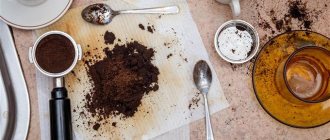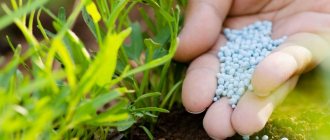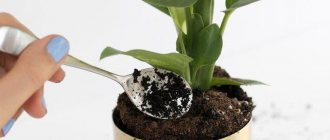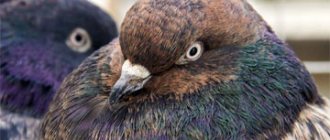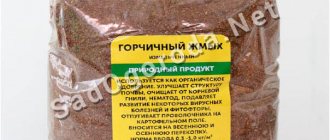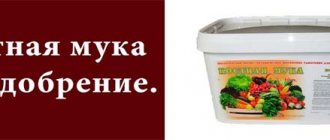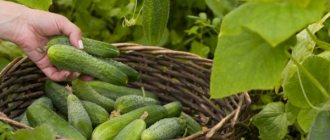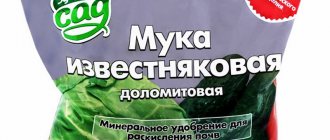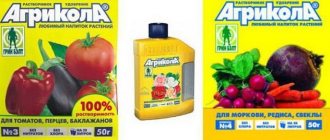Bone meal as fertilizer
First, I’ll tell you what I know about bone meal. The fertilizer is popular, but its price is low - this is good news. Bone meal contains a storehouse of microelements and biologically active substances: proteins, cystine, lysine, cobalt, iron, phosphorus, copper, nitrogen and even manganese. It is important to me that all these “vitamins” are available to plants, are easily absorbed, and do not remain in the soil for a long time.
I have identified 5 main advantages of bone meal:
1. Natural and safe fertilizer, does not burn the roots, does not poison the soil, water, etc.
2. Contains both mineral and organic substances in its composition, which means it replaces a whole set of fertilizers, saving time and money.
3. Universal, has no restrictions on use, suitable for vegetables, flowers, fruit and berry crops, ornamental shrubs, seedlings and adult plants.
4. It’s affordable, you spend a little at a time, it lasts a long time – these are three advantages at once!
5. Can be used in dry and liquid form: convenient for feeding different crops and at different times of the year.
I also noticed for myself that bone meal has a good effect on the quality and quantity of the harvest. This is also noted by other summer residents.
Advantages and disadvantages of the composition
Despite its natural origin, bone meal as a fertilizer has not only advantages, but also disadvantages. It is worth studying the effect of the substance on plants in advance so as not to make a mistake with the choice of fertilizing.
Benefits of choosing bone meal for plants:
- Natural origin, biodegradable. Over the course of eight months, the flour is processed and removed from the soil. The soil is not polluted and does not contain an excess of nutrients.
- Even with a single use, noticeable results will appear, and with regular use, the effect will be consistently positive.
- Fertilizer can be used throughout the growing season, but no later than 10 days before harvest.
- Versatility - all plants, even decorative ones, love feeding with bone meal.
- Low cost, availability in the regions.
- A concentrated composition that allows you to use fertilizer economically.
- Can be used in dry or diluted form.
There are few disadvantages, but they need to be taken into account. The concentration of phosphorus and other substances differs in different types of fertilizer. If you buy a composition that is poor in the required element, the plants will not receive the necessary support. The main disadvantage is associated with the excessive use of fertilizing. From oversaturation with phosphorus and other useful components, plants begin to wither and rot.
My tips for using bone meal
- Bone meal can be used throughout the warm period. However, try to finish fertilizing 14-15 days before harvest.
- Keep in mind that bone meal contains approximately 15% phosphorus by weight. This must be taken into account and the dosage calculated correctly. If there is a severe phosphorus deficiency in the soil, large volumes of bone meal will have to be added to make up for the deficiency.
- If you use bone meal for deacidification or loosening, make sure that there is no overdose of phosphorus in the soil. This is rare, but some gardeners sometimes go overboard.
Meat and bone meal: differences from bone meal, rules and scope of application
Bare bone is used to produce bone ash, and a small amount of meat and skin is burned during processing. The raw material for the meat-and-bone type of fertilizer is animal waste (20-50% veins or fat, depending on the type of final product). These are usually leftovers from a slaughterhouse (carcasses, trimmed bones, skin, hooves). Composition of meat and bone meal: Ca (up to 12%), P (up to 6%), Na (up to 2%), fat (up to 11%), moisture (up to 9%), ash (up to 28%), protein (from 50 %).
Often farmers are interested in what is bone meal for and what is meat and bone meal for? The first is an odorless, white or light gray substance, which is a phosphorus fertilizer. And meat and bone meal, according to the instructions for use, is used as an additive in the feed of farm animals; it has a brown color with a reddish tint and a strong odor. Granular mixtures with crushed grain are used in finished pet food.
If meat and bone dust is added to the soil, then under the influence of the sun and humidity it stimulates the reproduction of insects. Meat and bone meal is used less frequently as fertilizer: only on large areas and for mechanical digging.
My tips for adding bone meal
The method of applying bone meal usually varies depending on what crop needs to be fed and when. For example, you want to fertilize the soil in the beds where vegetables will grow in the future. Then the best option is to sprinkle bone meal over the surface of the soil in as even a layer as possible. Then dig it up and embed it in the ground. To make the fertilizer more quickly available to the roots, the bed needs to be watered generously.
Another example: you need to feed already growing vegetables. Then spray flour on the surface of the soil around the plants; before doing this, the soil needs to be watered and loosened.
| Consider the composition and type of soil on the site. On heavy, damp soils, it is better to apply bone meal diluted. When feeding vegetables at the roots, it is also better to use a fertilizer solution. |
What is bone meal: what is it made from and composition
Bone meal is a product of processing the bones of animals and birds, for the production of which they are taken from meat processing plants and livestock breeding complexes. It is a light brown powder. Flour is obtained in 2 different ways:
- The raw bone is crushed into pieces and then ground to a powder. In addition to phosphorus, it also contains nitrogenous organic substances;
- The bones are boiled to extract the fat, then steamed under pressure to extract the glue, and then ground to a powder.
Bone meal obtained using the latter method is most often used as fertilizer. It is used in the vegetable garden: this organic fertilizer is used to feed garden, ornamental and horticultural crops.
The use of bone meal is due to the presence of nitrogen (up to 1%), calcium (40-45%) and phosphorus (29-34%) in it. In terms of the content of the last element, it can be compared with the most widely used phosphorus-containing fertilizer - superphosphate or with another product - phosphate rock.
It also contains minerals: sulfur, sodium, chlorine, copper, iodine, iron, magnesium, manganese and zinc. All components contained in the chemical composition have a beneficial effect on garden plants, which manifests itself over a long period of time, as there is a gradual release of useful elements into the soil, therefore bone meal is considered a slow-acting fertilizer.
Traditional recipes for fertilizers with bone meal
Bone meal also works well with other natural fertilizers. I often add it along with ash, shells, sand, humus - bone meal enhances their effect.
Top dressing with ash and bone meal
Wood ash contains up to 5% potassium, bone meal – up to 15% phosphorus. This combination leads to the growth and development of above-ground leaf mass and root growth. I usually mix flour and ash in a 2:1 ratio. I spray the resulting mixture over the surface of the soil and embed it into the soil by digging.
Feeding with shells and bone meal
Egg shells plus bone meal make an excellent fertilizer with potassium, calcium, magnesium and copper. I grind the shells into powder and mix them with bone meal in a 1:2 ratio. Usually I pour this mixture into holes and planting holes or scatter it over the surface of the soil and then dig it up.
Top dressing with humus, sand and bone meal
Bone meal, humus and river sand - this mixture serves as both a fertilizer and a loosening agent for the soil. You need 2 parts bone meal, 3 parts river sand and 1 part humus. I apply it both in dry form to fertilize and loosen the soil, and in liquid form. To prepare the infusion, mix the ingredients, add water and leave for 2 days. For watering, I dilute the concentrated infusion 6 times.
Video: Useful properties and features of adding bone meal
How to use
All garden plants love phosphorus:
- it increases immunity and creates invulnerability to diseases,
- the root system of young seedlings is guaranteed to be strong,
- its presence has a positive effect on increased flowering and fruiting.
The use of bone and fish meal in garden plots will have a beneficial effect on the composition of the soil, replenish nitrogen and phosphorus losses, and enhance cellular metabolism. The calculation of the proportions is as follows: 100 or 200 g of powder per 1 m2.
For young seedlings, flour is added directly to the hole before planting and mixed with soil:
- for fruit trees 200 g is enough,
- for berry bushes - 100 g.
Next time the powder can be used after 2 years.
Attention! Phosphorus nutrition can be applied not only in spring, but also in autumn. Due to its slow dissolution, it will not lose its qualities during wintering.
The instructions for using bone meal are quite simple:
- For potatoes and eggplants, organic matter is added when digging the soil (200 g per 1 m) a week before planting. There is no point in pouring separately into the recess; it will take too much time.
- For pepper, pour 20 g of the substance into each well and mix with soil.
- For tomatoes and cucumbers, 30 g of powder in a hole when planting seedlings will be enough. There will be enough phosphorus for them for the whole season.
- For beets and carrots, the additive is poured into loose soil during the first thinning. For 1 m2 50 g will be enough.
- For strawberries, you can use digging (200 g per 1 m2) or adding 20 g of powder per plant.
- For bulbous plants, combine 20 g of powder with soil and pour it into the hole with the bulb. Tulips, lilies, hyacinths, daffodils, etc. respond well to this method.
- For roses and peonies, incorporating 50 g of fertilizer into the soil is suitable. It can be done once every three seasons, this will promote abundant flowering.
- For seedlings, a nutrient mixture is prepared in the fall by mixing 1 kg of soil with 1 tbsp of flour. Over the winter it will be enriched with useful components and in the spring it will produce strong shoots.
- For indoor plants, use 1 g of product per 1 kg of soil.
Attention! House azaleas grow well in an acidic environment. Bone fertilizer will neutralize the soil, and this will be harmful to the plant.
Bone fertilizer dissolves well in water, so on heavy clay soils it can be used in liquid form. 1 kg of the substance is poured into 10 liters of hot water and infused for a week. The working solution can be used for all agricultural crops, especially fruits and berries.
Is there a difference between bone meal and meat and bone meal?
Definitely yes! The first type of fertilizer is prepared from bare bones, and even if there are some traces of muscle tissue left on them, it will all burn when heated. The second type is made from the carcasses of dead animals, and the bulk is made up of muscles and skin.
Bone flour
Meat and bone powder
As an organic fertilizer, meat and bone powder is not used in the garden, otherwise the processes of rotting and decomposition will begin there, with the resulting odors and microbes. It is added to the feed of pigs, cows, bulls, horses and chickens during protein starvation.
Attention! If the instructions mention that meat and bone meal can be consumed as a fertilizer for plants, this is either an advertising ploy or a completely different drug.
Do not forget that long-term storage at high humidity can destroy vitamins, trigger harmful chemical reactions and spoil such an invaluable drug as bone meal.
Serious mistakes gardeners make when using bone meal
- Apply fertilizers without first testing the soil.
Gardeners often complain that fertilizing is not beneficial. This happens if the powder is used on alkaline or neutral soils. Calcium, which is contained in flour, changes the pH level towards an increase. In such an environment, beneficial substances do not actually dissolve. To be effective, you need a pH value < 6. Acidity can be determined using litmus paper and a special device. And only after that decide whether it is possible to add bone or fish meal.
Fish flour
Fishmeal, as a fertilizer, has a similar effect on vegetation. Fish bones contain a lot of protein, nitrogen and useful minerals. All sea creatures are suitable for making flour - sardines, pollock, shrimp, anchovies, etc.
Do you use folk signs in gardening?
The key differences are:
- type of raw material used (fish ridges);
- slightly reduced amount of phosphorus;
- Often the product contains soft tissue;
- increased amount of nitrogen, concentration reaches 10%. The microelement promotes the rapid growth of green mass and roots.
Instructions for using fishmeal often contain recommendations regarding the preparation of liquid fertilizer. To make it you will need fish powder; it is infused in water. Most often, instructions for using fishmeal imply the need to mix the drug with other fertilizers.
Fishmeal as a fertilizer has a similar effect on vegetation
Beneficial influences:
- contributes to obtaining a larger harvest;
- compacts the structure of fruits, improving the quality of their storage;
- increases the sugar content of fruits;
- accelerates plant development;
- enriches the composition of the soil.
It is recommended to add fish powder in the fall, because the process of processing the substance and releasing easily digestible elements takes over six months.
The instructions for using fishmeal allow the substance to be used for almost all crops. The best effect is observed on nightshade plants: potatoes, tomatoes, eggplants.
In terms of dosage, the instructions for using fishmeal have the following instructions:
- when digging – 100 g/m2;
- when laying in beds - 1–2 tbsp. l. per plant;
- when planting seedlings - 2–3 tbsp. l. into the hole.
To achieve the best results, mixing powder from animal and fish bones helps to obtain fish bone meal. Abroad, such fertilizing is used quite often, but in Russia it remains rare.
Nitrogen is extremely important for all plants, but this element can cause an overdose, which will worsen their condition. Do not neglect the recommendations, but use fish bone meal in the indicated dosages. In case of an overdose, the time of fruit development increases, the plants become more vulnerable to stress: diseases, heat or cold.
Fertilizer based on fishmeal
For rooting seedlings
When planting tomatoes, fertilizer is applied to each hole.
In order for the seeds to germinate and take root, a light peat-sand substrate is needed (find out → how to use peat as a top dressing + reviews). For seedlings, it is important that the soil contains enough phosphorus. It is he who is responsible for the appearance and growth of young roots. When preparing the mixture, high-moor peat is used, its acid-base balance is pH – 3, that is, a strongly acidic reaction. In combination with bone meal, an effective result is achieved, provided the dosage is 1:100. In other words, for 100 parts of substrate, 1 part of flour is needed.
How to make fertilizer with your own hands
Organic bone meal fertilizer can also be prepared at home.
Cooking algorithm:
- wash the bones thoroughly (this will prevent the process of rotting);
- dry the bones by spreading them on a towel;
- put the bones in the oven, preheated to 200 degrees;
- after a third of an hour, remove the bones from the oven and let them cool;
- grind the bone remains in any convenient way (protect your hands with gloves).
Fish bone powder is prepared using the same algorithm.
If the mineral supplement is stored correctly, its shelf life is unlimited . The most important thing is to ensure that no moisture gets into the bag with the product. Choose a storage location that is dark, cool and dry.
